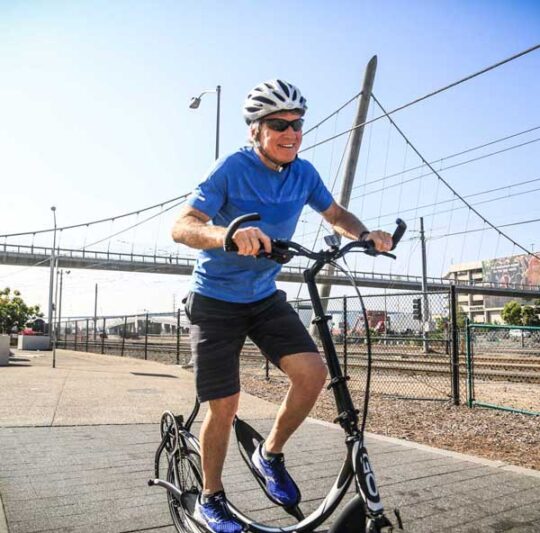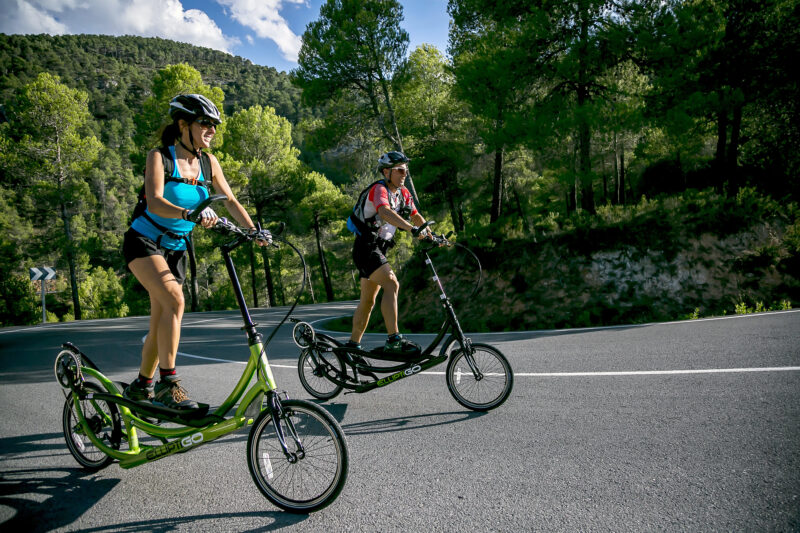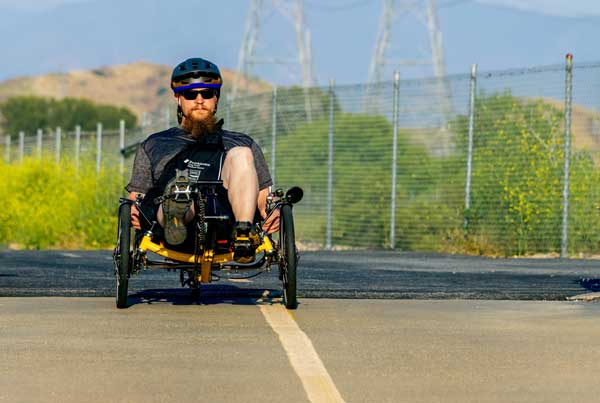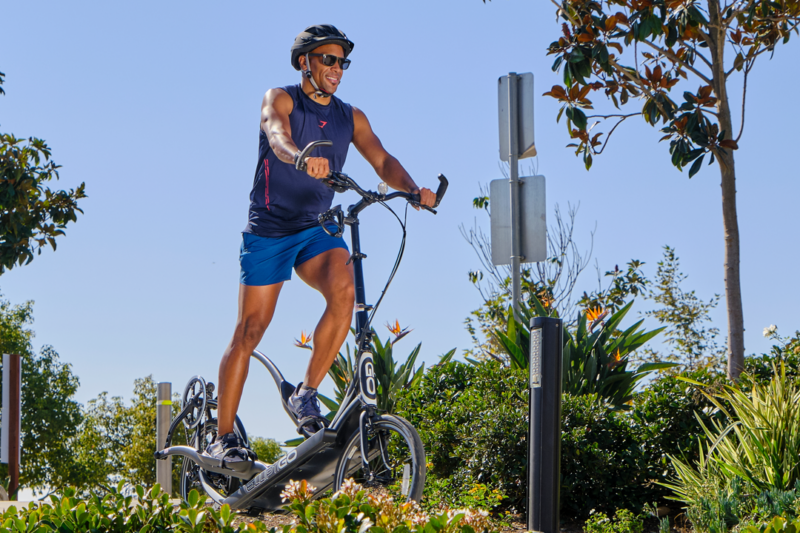 If you’re looking for a fun, low-impact way to stay active and support your long-term health, chances are you’ve come across both recumbent bikes and ElliptiGO bikes. Maybe you’ve already invested in one, or you’re considering whether either is right for you. These bikes offer different experiences, but they share a common purpose: helping you move your body, protect your joints and have fun while doing it. Whether you’re recovering from an injury, easing back into fitness or simply seeking a more enjoyable way to exercise, understanding what each bike offers can help you make the most of your ride.
If you’re looking for a fun, low-impact way to stay active and support your long-term health, chances are you’ve come across both recumbent bikes and ElliptiGO bikes. Maybe you’ve already invested in one, or you’re considering whether either is right for you. These bikes offer different experiences, but they share a common purpose: helping you move your body, protect your joints and have fun while doing it. Whether you’re recovering from an injury, easing back into fitness or simply seeking a more enjoyable way to exercise, understanding what each bike offers can help you make the most of your ride.
Recumbent Bikes: Comfort and Support
Recumbent bikes are known for their laid-back riding position and supportive seat, which can make them feel more like a lounge chair than a piece of fitness equipment. That comfort is a big draw, especially for those dealing with back pain, joint issues or mobility challenges. These bikes are low to the ground, and the pedals are located in front of the rider, rather than below the rider.
Where to find them: Outdoor recumbent bikes and trikes are sold online as well as at some specialty bike shops. There are even recumbent mountain trikes and quads, which have four wheels for maximum stability on trails.
 ElliptiGO Bikes: Dynamic and Engaging
ElliptiGO Bikes: Dynamic and Engaging
ElliptiGO bikes offer a completely different kind of ride — one that feels more like running or elliptical training, but without the pounding on your joints. You ride standing up, which engages your core and eliminates the saddle soreness associated with traditional bikes. ElliptiGO offers elliptical bikes, which feature a gentle, long-stride motion, and stand-up bikes, which have a circular pedaling motion.
Where to find them: ElliptiGO bikes are sold online through ElliptiGO.com and at specialty bike shops. A network of ElliptiGO Enthusiasts offer test rides across the country. ElliptiGO also offers electrified versions of their bikes for a boost of power, and the Mountain Stand Up Bike (MSUB), which is specifically designed for trail riding.
The Top 3 Shared Benefits of Recumbent Bikes and ElliptiGO Bikes
ElliptiGO bikes and recumbent bikes offer different riding experiences, but they provide many of the same benefits.
- A Low-Impact Workout
ElliptiGO’s two bike styles both deliver a low-impact, full-body workout. ElliptiGO’s elliptical bikes offer a long-stride motion that feels like gliding forward with a natural running stride, without the impact. ElliptiGO’s stand-up bikes use a circular pedaling motion for a more comfortable, upright ride than a traditional bicycle. Both options minimize joint strain while maximizing cardio and muscle engagement.
The reclined position of a recumbent bike distributes your weight more evenly than traditional bikes. The supportive, seated design helps minimize stress on your knees, sit bones, wrists and lower back. This makes them a good option for people with back pain or joint issues.
- Designed for Comfort

Unlike traditional bicycles that often force riders into a hunched-over position, both ElliptiGO and recumbent bikes are designed with comfort in mind. ElliptiGO bikes support a natural standing position that promotes upright alignment, reducing strain on the back, shoulders and neck. Because ElliptiGO bikes have no seat, riders experience none of the seat pain associated with traditional bikes.
Recumbent bikes take a different approach, placing the rider in a laid-back, reclined position that provides full back support while extending the legs forward to pedal. The wider, cushioned seat of a recumbent bike offers back support. Recumbent bike fans find that their bike seats are far more comfortable than typical bike seats, allowing them to enjoy longer rides without the seat pressure that can make traditional cycling unpleasant.
Though the riding positions differ, both bikes eliminate the discomfort and spinal compression associated with conventional cycling, making them excellent choices for those seeking a more ergonomic ride.
- FUN!
ElliptiGO bikes and recumbent bikes offer unique riding experiences that sets them apart from traditional bicycles. With ElliptiGO bikes, riders stand tall and move forward smoothly. ElliptiGO’s elliptical bike riders say the feeling is like running on air, and ElliptiGO’s stand-up bike riders feel comfortable and powerful in the upright riding stance. Recumbent bikes, on the other hand, offer a laid-back cycling experience. The reclined position makes for a relaxed ride, and the low-to-the-ground design is reminiscent of a go-kart (without the engine). Both types of bikes bring back the simple childhood joy of riding for the fun of it — no sore back, no stiff neck … just movement, freedom and miles of smiles.
How ElliptiGO Bikes and Recumbent Bikes Differ: 3 Unique Benefits of Each Type of Bike
While ElliptiGO and recumbent bikes offer many of the same benefits, they also differ in significant ways.
ElliptiGO bikes stand out for delivering a dynamic, calorie-torching full-body workout. In fact, a University of California, San Diego (UCSD), study found that ElliptiGO cycling burns 33% more calories than standard biking. Unlike traditional bikes, they engage not only your legs but also your core and upper body, thanks to the upright design. This design also allows ElliptiGO cyclists to climb hills, offering a  challenging, resistance-based workout that builds strength and endurance as you power up inclines. Plus, with the rider in a tall, standing position, ElliptiGO bikes offer enhanced visibility and line of sight. Riders can see and be seen more easily on the road, which adds an extra layer of safety to every ride.
challenging, resistance-based workout that builds strength and endurance as you power up inclines. Plus, with the rider in a tall, standing position, ElliptiGO bikes offer enhanced visibility and line of sight. Riders can see and be seen more easily on the road, which adds an extra layer of safety to every ride.
Recumbent bikes offer several practical advantages that make them appealing for both casual riders and long-distance cyclists. Their aerodynamic design allows for a more efficient ride, reducing wind resistance and making it easier to maintain speed with less effort. Many recumbent models also feature superior cargo capacity, with space for bags or panniers behind or alongside the seat, which is ideal for touring or running errands. Additionally, three- and four-wheeled recumbent bikes provide excellent stability, making them a great option for riders who want extra balance support or prefer a more secure, grounded ride.
Combined Low-Impact Cardio: Why Some People Ride Both
We asked our community, and many ElliptiGO riders, like Ellyn Waller Marell, Phillippe Jung, and Tracy Ward, also own recumbent bikes currently or have in the past. The bike styles complement each other, and each can serve a different purpose in your fitness routine. It’s not about replacing one type of bike with the other—it’s about expanding your options and finding a balance that keeps you active, healthy, and motivated.
 Some riders use a recumbent bike for recovery rides, then take the ElliptiGO out when they want to get their heart rate up and enjoy the fresh air. Others find that after years of riding recumbents, ElliptiGO bikes offer a new way to challenge their body while still protecting their joints. Using both types of bikes can also help prevent workout fatigue or boredom. Chuck Ankeny, who rides a two-wheel recumbent and traditional bikes, recently acquired an ElliptiGO 8C. He says, “I’m finding the benefits of the ElliptiGO are really helping my overall fitness. It is the perfect cross-training for me.”
Some riders use a recumbent bike for recovery rides, then take the ElliptiGO out when they want to get their heart rate up and enjoy the fresh air. Others find that after years of riding recumbents, ElliptiGO bikes offer a new way to challenge their body while still protecting their joints. Using both types of bikes can also help prevent workout fatigue or boredom. Chuck Ankeny, who rides a two-wheel recumbent and traditional bikes, recently acquired an ElliptiGO 8C. He says, “I’m finding the benefits of the ElliptiGO are really helping my overall fitness. It is the perfect cross-training for me.”
Depending on the terrain you ride, one bike may be better for you than another. Bill Cornelius rides a variety of bikes. He says, “I ride my diamond (traditional) bike for trails, my ElliptiGO bike for a cardio workout, and my recumbent when I want to be out all day.”
“I rode a recumbent bike before getting an ElliptiGO 11R,” says Anne Laflamme. “The recumbent was very comfortable to ride but terrible on hills.”
Steve Cottren says that when he did the Great Victorian Bike Ride, he met up with lots of cyclists on all sorts of bikes. He observed that recumbent bikes were well suited to flat terrain and less vulnerable to headwinds than other bikes, but because they are low to the ground, the riders had visibility issues.
“Two-wheel recumbents were on pace with racers, but hills were their nemesis,” Steve shares. He notes that three- or four-wheel recumbents are likely to be good choices for bike tours because they can carry a lot of gear, are very stable and have a wider range of gearing.
ElliptiGO rider Stuart Blofeld points out, “A BIG benefit for both recumbent and ElliptiGO riders especially, for long-distance riding, is the neutral head/neck position.”
Stuart shares that a friend got Shermer’s neck, a condition in ultra-distance cycling where the neck muscles become fatigued and can no longer support the head, during a 2017 attempt to ride 2,100 kilometers (1,305 miles) around the Wild Atlantic Way within a week. Stuart’s friend was only 100 kilometers (62 miles) from the finish, but he was unable to complete the ride due to Shermer’s neck. Stuart successfully completed the same ride on an ElliptiGO bike. His friend now rides a recumbent bike. “The takeaway here is that both ElliptiGO and recumbent bikes provide a far more neutral body position [than traditional bikes], which is healthier, especially over long distances,” Stuart says.
 Making the Best Choice for You
Making the Best Choice for You
Choosing between a recumbent bike and an ElliptiGO bike (or deciding to invest in both) comes down to your goals, lifestyle and preferences. If you need back support, a recumbent bike might be best for you. If balance is an issue, a three- or four-wheeled recumbent bike may be a great fit.
However, some cyclists find that the low-to-the-ground position of a recumbent bike can result in a rough ride or make it difficult to get a good workout. Ken Pevay rode a two-wheeled recumbent bike about 1,500 miles per year before switching to the ElliptiGO 11R. He finds that his new elliptical bike provides a “more comfortable upright position that is less jarring on my spine and a much better cardio workout.” Ken adds, “Now I get a full-body workout.”
If seat pain is an issue or you’re craving a highly effective workout with indoor/outdoor flexibility, ElliptiGO bikes might be what you’re looking for. And with more than 40,000 ElliptiGO bikes sold, when you purchase one, you’re joining a robust, enthusiastic community that will welcome you.
Whichever you choose, know that there’s no wrong answer. It’s not about choosing the “better” bike—it’s about finding what moves you.
Summary Comparison
| Recumbent Bikes | ElliptiGO Bikes | |
|---|---|---|
| Low impact | ✓ | ✓ |
| Comfortable | ✓ | ✓ |
| FUN! | ✓ | ✓ |
| Aerodynamic | ✓ | |
| Cargo capacity | ✓ | |
| Stability (3-wheel and 4-wheel recumbents) | ✓ | |
| Full-body workout | ✓ | |
| Calorie scorcher | ✓ | |
| Hill-climbing capability | ✓ | |
| Visibility/line of sight | ✓ |


One Response
I have both. However, I don’t use the recumbent in the UK because we simply don’t have the necessary infrastructure, and they’re too hazardous on normal roads. However, I use the Elliptigo every day for basic transportation. I’ve had it for 11 years. I probably do an hour or two a day on it. It’s probably done 10-12,000 miles.